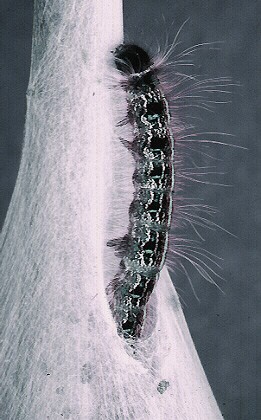The
tent of the eastern tent caterpillar is among the largest built by any
tent caterpillar. The tents are constructed in the crotch of the host
tree and are typically oriented so that the broadest face of the
structure faces the southeast, taking advantage of the morning
sun.
The
tent has openings that allow the caterpillars to enter and exit the
structure. Openings are formed where branches jut from the
structure but are most common at the apex of the tent.
Caterpillars
continue to expand their tent until they enter the last phase of their
larval life. The sixth-instar caterpillar conserves its silk for
cocoon construction and adds nothing to the tent. The tents appears
multifunctional. They facilitate basking, offer some protection
from enemies, provide for secure purchase, and act as a staging site
from which the caterpillars launch en masse forays to distant feeding
sites. The elevated humidity inside the tent may facilitate
molting
The
caterpillars typically add silk to the structure at the onset of each
of their daily activity periods. Silk is added directly to the
surface of the tent as the caterpillars walk back and forth over the
structure. The silk is laid down under slight tension and it eventually
contacts, causing the newly spun layer of silk to separate from the
previously spun layer. The tent thus consists of discrete layers of
silk separated by gaps within which the caterpillars rest.
In this time lapse video, the arrow marks the location on the outer layer of silk at the beginning of four descrete bouts of en masse spinning occuring at approximately 6 hour intervals.


